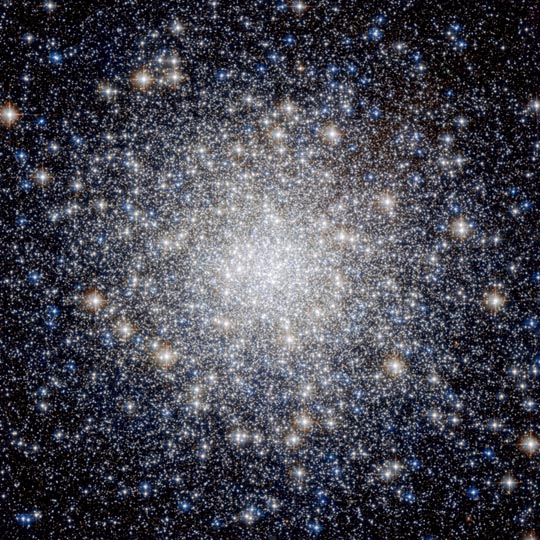
Globular cluster
RA 17h 17m 07.39s Dec +43° 08' 09.4"
Hercules
6.3
diameter of 14 arc-min
25000 light years
ESA/Hubble & NASA, Ack: Gilles Chapdelaine
December 8, 2014
ABOUT THIS IMAGE:
This striking new NASA/ESA Hubble Space Telescope image shows a glittering bauble named Messier 92. Located in the northern constellation of Hercules, this globular cluster — a ball of stars that orbits a galactic core like a satellite — was first discovered by astronomer Johann Elert Bode in 1777.
Messier 92 is one of the brightest globular clusters in the Milky Way, and is visible to the naked eye under good observing conditions. It is very tightly packed with stars, containing some 330 000 stars in total. As is characteristic of globular clusters, the predominant elements within Messier 92 are hydrogen and helium, with only traces of others. It is actually what is known as an Oosterhoff type II (OoII) globular cluster, meaning that it belongs to a group of metal-poor clusters — to astronomers, metals are all elements heavier than hydrogen and helium.
By exploring the composition of globulars like Messier 92, astronomers can figure out how old these clusters are. As well as being bright, Messier 92 is also old, being one of the oldest star clusters in the Milky Way, with an age almost the same as the age of the Universe.
From Wikipedia:
Messier 92 (also known as M92 or NGC 6341) is a globular cluster of stars in the northern constellation of Hercules. It was discovered by Johann Elert Bode in 1777, then published in the Jahrbuch during 1779. The cluster was independently rediscovered by Charles Messier on March 18, 1781 and added as the 92nd entry in his catalogue. M92 is at a distance of about 26,700 light-years away from Earth.
M92 is one of the brighter globular clusters in the northern hemisphere, but it is often overlooked by amateur astronomers because of its proximity to the even more spectacular Messier 13. It is visible to the naked eye under very good conditions.
Among the Milky Way population of globular clusters, Messier 92 is among the brighter clusters in terms of absolute magnitude. It is also one of the oldest clusters. Messier 92 is located around 16 kly (4.9 kpc) above the galactic plane and 33 kly (10 kpc) from the Galactic Center. The heliocentric distance of Messier 92 is 26.7 kly (8.2 kpc). The half-light radius, or radius containing half of the light emission from the cluster, is 1.09 arcminutes, while the tidal radius is 15.17 arcminutes. It appears only slightly flattened, with the minor axis being about 89% ± 3% as large as the major axis.
Characteristic of other globulars, Messier 92 has a very low abundance of elements other than hydrogen and helium; what astronomers term its metallicity. Relative to the Sun, the abundance of iron in the cluster is given by [Fe/H] = –2.29 dex, which equates to only 0.5% of the solar abundance. This puts the estimated age range for the cluster at 14.2 ± 1.2 billion years, or roughly the age of the Universe.
The cluster is not currently in a state of core collapse and the core radius is about 2 arcseconds. It is an Oosterhoff type II (OoII) globular cluster, which means it belongs to the group of metal-poor clusters with longer period RR Lyrae variable stars. The 1997 Catalogue of Variable Stars in Globular Clusters listed 28 candidate variable stars in the cluster, although only 20 have been confirmed. As of 2001, there are 17 known RR Lyrae variables in Messier 92. 10 X-ray sources have been detected within the 1.02 arcminute half-mass radius of the cluster, of which half are candidate cataclysmic variable stars.